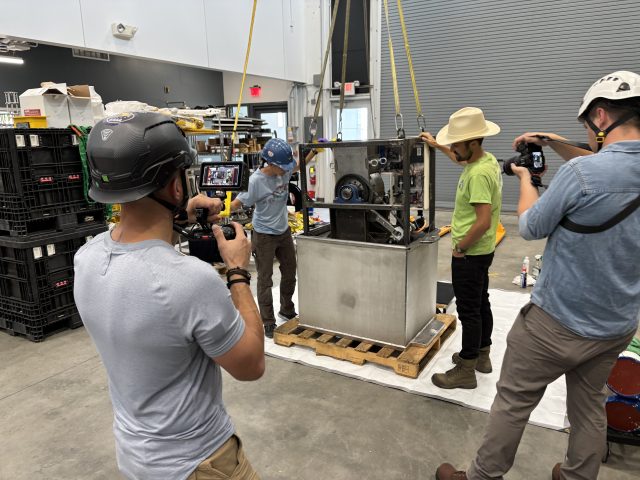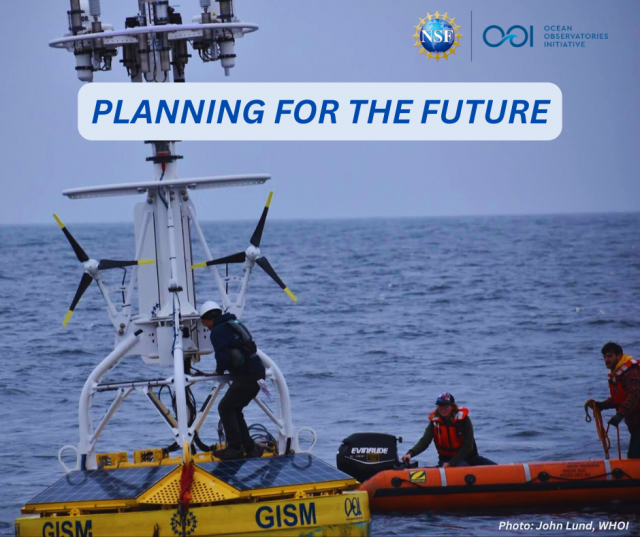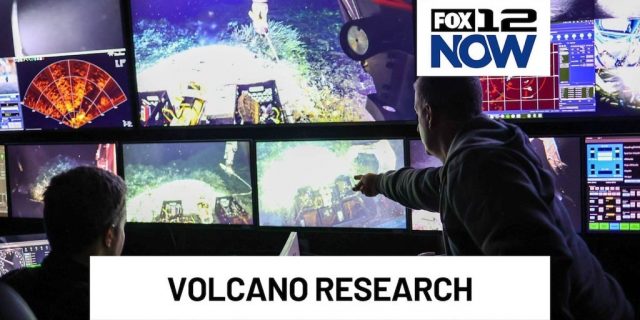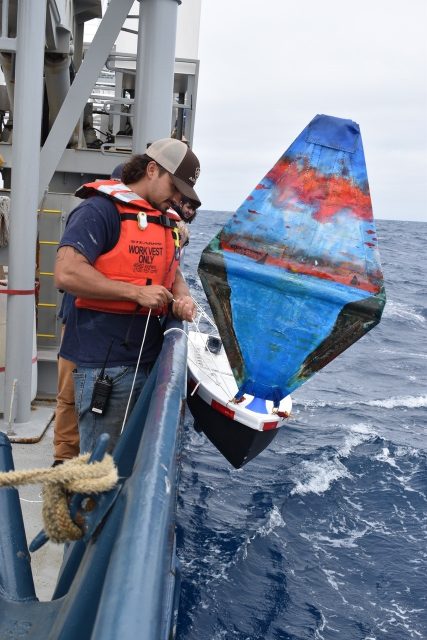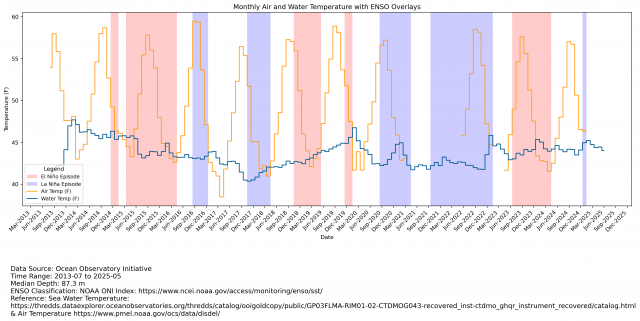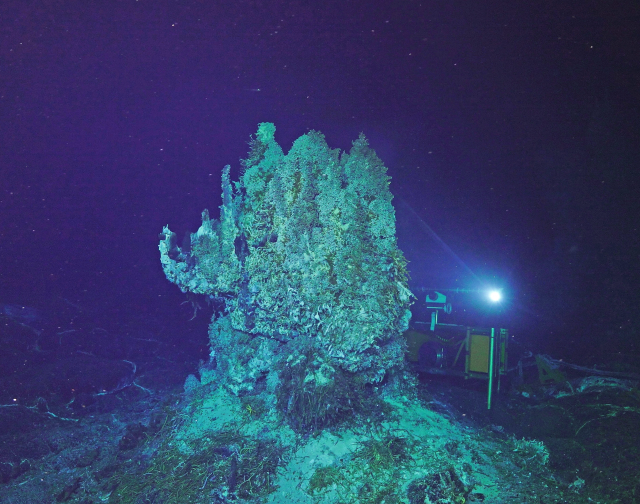Posts by Amber Coogan
RCA Broadband Provides First Report of Tremor-Like Signals Offshore Cascadia
The recent publication “Possible Shallow Tectonic Tremor Signals Near the Deformation Front in Central Cascadia” (Krauss et al., 2025) presents the first report of tectonic tremor-like signals offshore Cascadia. As described by the authors, deep slow-slip events in Cascadia—lasting from hours to weeks—have been documented by land-based stations for decades. These events can accommodate a significant portion of overall plate motion and may serve as precursors to megathrust earthquakes. Over the past two decades, significant tectonic tremor activity (1–10 Hz) has been observed as a feature of slow slip every 10.5–15.5 months beneath Vancouver Island to northern Oregon (Bombardier et al. 2024), with annual slip events equivalent to a magnitude ~6.5 earthquake. These typically occur well inland, at depths of approximately 30–40 km. Contrastingly, it is unknown whether slow-slip events and accompanying tectonic tremor occur at shallow subduction depths in the offshore region.
Krauss et al. (2025) analyzed data collected 2015-2024 from buried ocean-bottom seismometers (OBS) at two sites: Slope Base (2,920 m depth), located 5 km seaward of the deformation front, and Southern Hydrate Ridge (790 m depth), approximately 20 km landward. The analysis incorporated in-situ bottom current data. After applying short- and long-term averaging techniques, the study identified 85,000 signals at Slope Base and 30,055 at Southern Hydrate Ridge, encompassing T-phase events, ship noise, and tectonic tremor-like signals. Notably, tectonic tremor-like signals were observed exclusively at Slope Base.
These signals cannot be attributed to ship traffic or environmental noise. Instead, they are hypothesized to originate from slow slip on one of many nearby tectonic structures: the décollement fault, faults near the subduction zone front and outermost accretionary wedge, faults on the incoming Juan de Fuca Plate, or nearby strike-slip structures such as the Alvin Canyon Fault. However, without additional observations of these signals on multiple stations, it is unclear whether they are tectonic or represent another signal altogether.
Future deployments, such as those planned through the Cascadia Offshore Subduction Zone Observatory (COSZO) will improve our ability to pinpoint the sources of these offshore tremors. The full dataset and results are available on GitHub (https://github.com/zoekrauss/obs_tremor) and archived on Zenodo (https://zenodo.org/records/14532861).
[caption id="attachment_37111" align="alignnone" width="512"] Figure 1. a) Location of the Regional Cabled Array cabled broadband seismometers (OBS’s -cyan triangles) offshore Newport Oregon and an autonomous instrument (purple triangle), earthquakes (pink circles) and along and just offshore the Cascadia Margin. b) sustained tremor-like signals from the broadband at Slope Base. c) Subsurface structure across strike of the margin showing location of Slope Base and Southern Hydrate Ridge OBS’s, accretionary margin faults and demarcation of a boundary interpreted to be a protothrust between the sedimentary column and the incoming Juan de Fuca Plate crust.[/caption]
Figure 1. a) Location of the Regional Cabled Array cabled broadband seismometers (OBS’s -cyan triangles) offshore Newport Oregon and an autonomous instrument (purple triangle), earthquakes (pink circles) and along and just offshore the Cascadia Margin. b) sustained tremor-like signals from the broadband at Slope Base. c) Subsurface structure across strike of the margin showing location of Slope Base and Southern Hydrate Ridge OBS’s, accretionary margin faults and demarcation of a boundary interpreted to be a protothrust between the sedimentary column and the incoming Juan de Fuca Plate crust.[/caption]
___________________
References:
Krauss, Z., Wilcock, W.D.S., and Creager, K.C. (2025) Possible shallow tectonic tremor signals near the deformation front in Central Caldera. Seismica, https://seismica.library.mcgill.ca/article/view/1540.
Bombardier, M., Cassidy, J.F., Dosso, S.E., and K. Honn (2024) Spatial distribution of tremor episodes from long-term monitoring in the northern Cascadia Subduction Zone. Journal of Geophysical Research, https://doi.org/10.1029/2024JB029159.
Read MoreOOI Contributions Featured at 2025 Slocum Glider User’s Conference & Sentinel Launch
The global oceanographic community gathered in Woods Hole October 7–9 for the 2025 Slocum Glider User’s Conference. The meeting convened users, scientists, engineers, and mission planners to advance next-generation autonomous ocean observing.
For OOI, the event provided a timely forum to share nearly a decade of experience integrating Slocum gliders into sustained, basin-scale observing. OOI has deployed Slocums to collect high-resolution profiles of temperature, salinity, oxygen, chlorophyll, nitrate, optical properties, and currents across energetic and climatically sensitive regions. These long records (gathered in all seasons and weather) have supported research on boundary currents, carbon cycling, marine heatwaves, ecosystem change, and storm-ocean interaction.
The OOI Team presented two posters at the conference, one documenting eight years of glider operations at the OOI Pioneer New England Shelf Array and the other describing the operational approach and initial outcomes from the Pioneer Mid-Atlantic Bight Array, which was started in April 2004. Diana Wickman presented a talk on “Tips, Tricks and Best Practices” for long-duration glider missions, an area where OOI has unique expertise.
The conference week concluded with the October 10 launch of the Sentinel Mission, the first attempt to autonomously circumnavigate the globe by AUV, using REDWING, a Slocum Sentinel Glider.
[caption id="attachment_37105" align="alignnone" width="2560"] Diana Wickman (WHOI) gives a tour of the Glider Lab at LOSOS. © Andy Robinson / WHOI[/caption]
[caption id="attachment_37106" align="alignnone" width="2560"]
Diana Wickman (WHOI) gives a tour of the Glider Lab at LOSOS. © Andy Robinson / WHOI[/caption]
[caption id="attachment_37106" align="alignnone" width="2560"] Tour of the Glider Lab at LOSOS. © Andy Robinson / WHOI[/caption]
[caption id="attachment_37101" align="alignnone" width="1920"]
Tour of the Glider Lab at LOSOS. © Andy Robinson / WHOI[/caption]
[caption id="attachment_37101" align="alignnone" width="1920"] Peter de Menocal (WHOI) speaks at Sentinel Mission Launch event. © Amber Coogan / WHOI[/caption]
Peter de Menocal (WHOI) speaks at Sentinel Mission Launch event. © Amber Coogan / WHOI[/caption]
![]()
![]()
PAMPortal Highlights OOI Acoustic Data
OOI data are now featured in PAMPortal, a new cloud-based tool that makes it easier for researchers to explore acoustic detections and soundscape metrics. PAMPortal integrates the passive acoustic analysis workflow using PAMGuard and PAMpal as part of its internal processing services (rather than as general public support tool for independent PAMGuard or PAMpal processing). This setup allows users to engage directly with marine mammal detection products and acoustic summaries.
For the OOI community, this connection is especially exciting. The tool’s built-in example dataset is drawn from OOI acoustic data. By selecting “Use Example Data,” users will see an informational card that acknowledges OOI and links to additional resources, providing a clear entry point into OOI’s rich acoustic archive.
By presenting OOI data in an accessible, interactive format, PAMPortal aims to make it easier to work with complex acoustic datasets and encourages broader use of OOI resources in research and discovery.
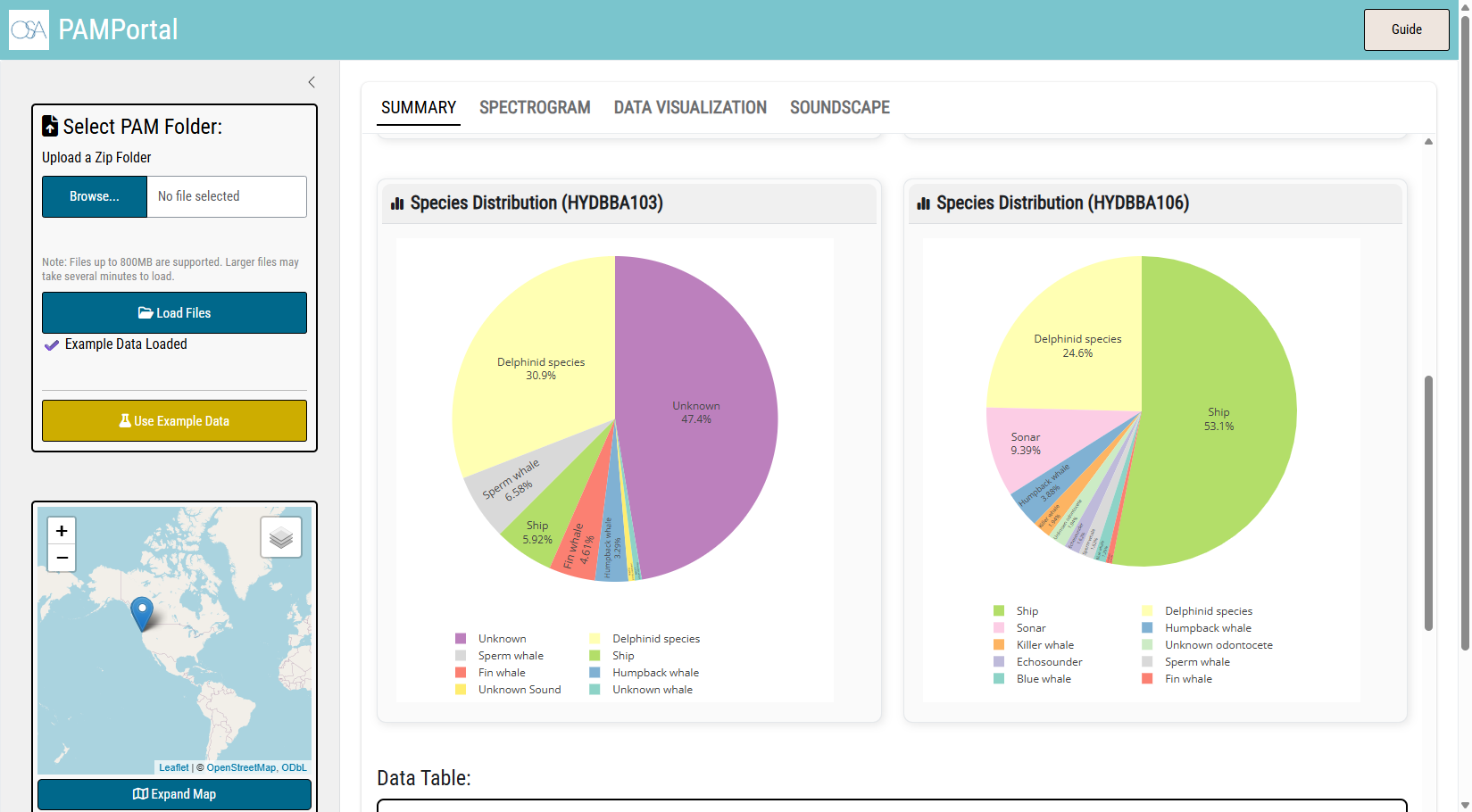
Wave Energy Converter Project Moves Toward At-Sea Testing
OOI, in partnership with the U.S. Department of Energy’s (DOE’s) Water Power Technologies Office (WPTO) is preparing to deploy a wave energy converter (WEC) device on the Pioneer MAB central surface mooring. The project aims to demonstrate how wave energy can provide reliable, renewable power for sustained ocean observation.
A recent visit brought together the team, which is comprised of experts from OOI, WPTO, Sandia National Laboratories, the National Renewable Energy Laboratory (NREL), Evergreen Innovations, Johns Hopkins University, East Carolina University, and Woods Hole Oceanographic Institution (WHOI) to focus on engineering validation for the Pioneer WEC, a critical step before at-sea testing later in the fall.
During the visit, the team carried out subsystem testing, integrated the WEC with the buoy, assembled the full system, and tested it under varied scenarios. This rigorous preparation is crucial for de-risking the upcoming deployment.
This project represents an important step toward persistent ocean observing systems. By reducing reliance on ship-based servicing and enabling longer-term autonomous operation, wave energy has the potential to transform how sustained ocean science is conducted.
[caption id="attachment_37035" align="alignnone" width="1813"]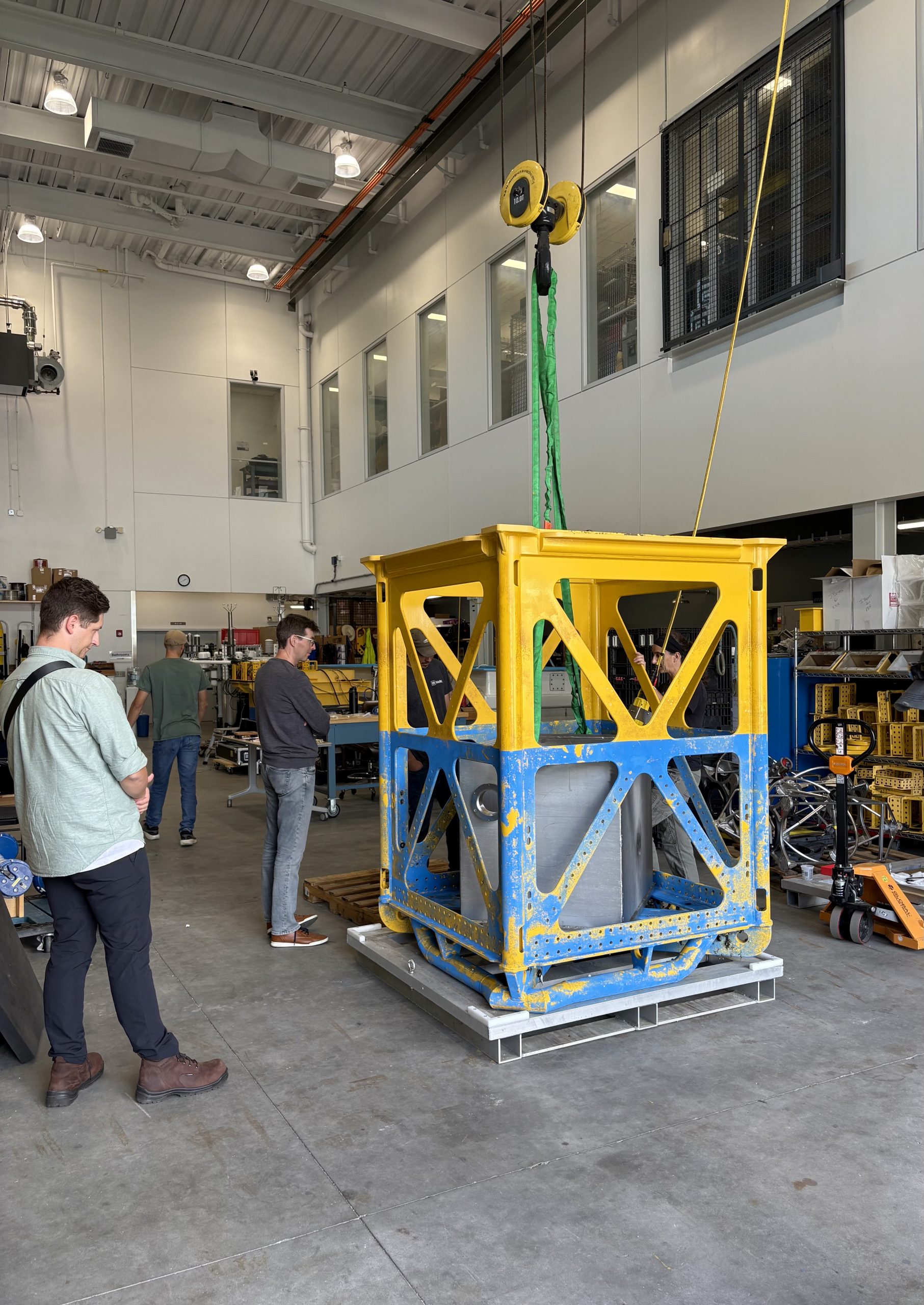 Taylor Mankle, NREL, and Johannes Spinneken, Evergreen Innovations, inspect the WEC housing installed in the buoy base. © Amber Coogan, WHOI[/caption]
[caption id="attachment_37037" align="alignnone" width="2560"]
Taylor Mankle, NREL, and Johannes Spinneken, Evergreen Innovations, inspect the WEC housing installed in the buoy base. © Amber Coogan, WHOI[/caption]
[caption id="attachment_37037" align="alignnone" width="2560"]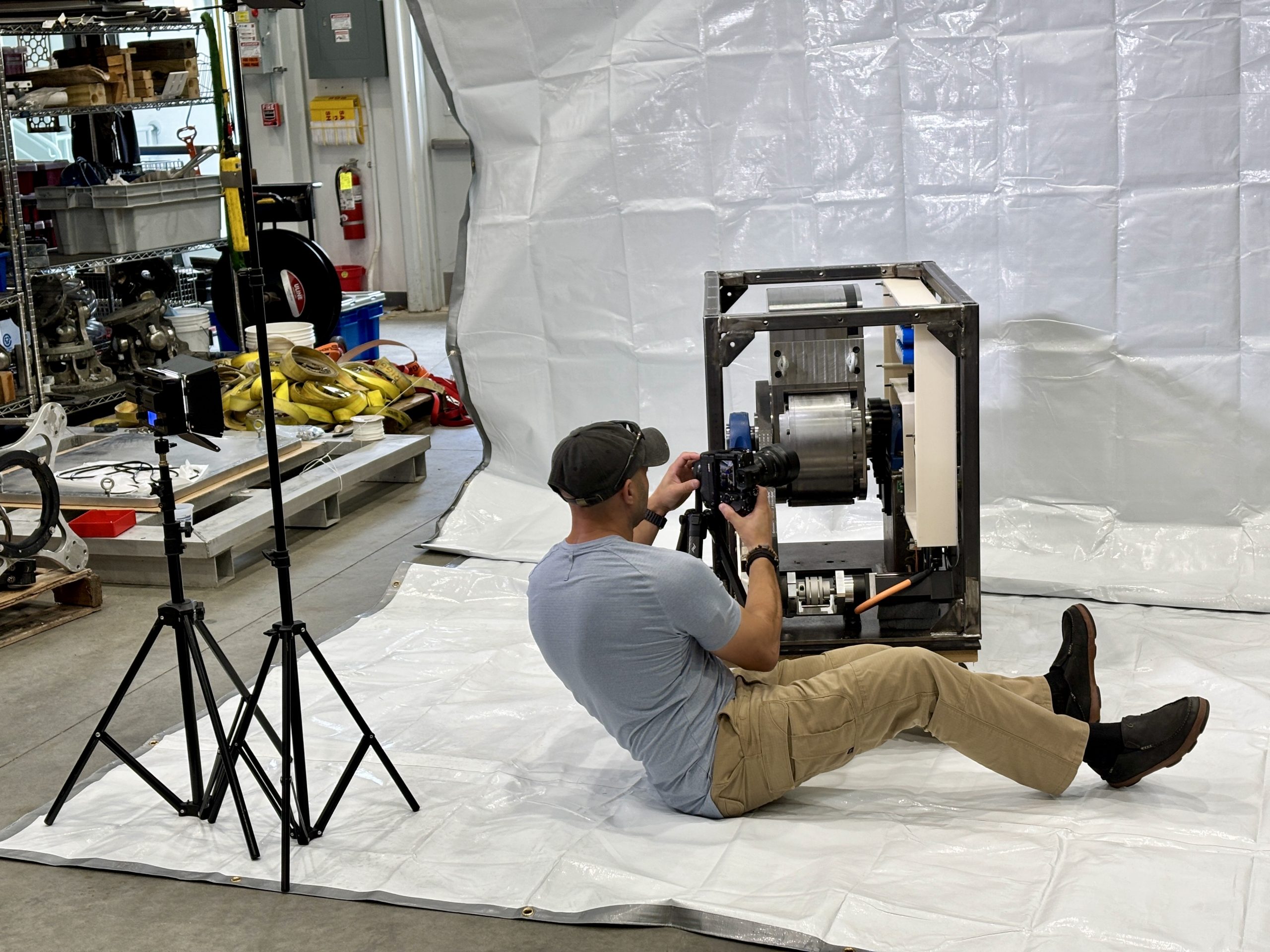 Joshua Bauer, NREL, captures still images for a 360° photographic reconstruction of WEC. © Ken Kostel, WHOI[/caption]
[caption id="attachment_37038" align="alignnone" width="2560"]
Joshua Bauer, NREL, captures still images for a 360° photographic reconstruction of WEC. © Ken Kostel, WHOI[/caption]
[caption id="attachment_37038" align="alignnone" width="2560"]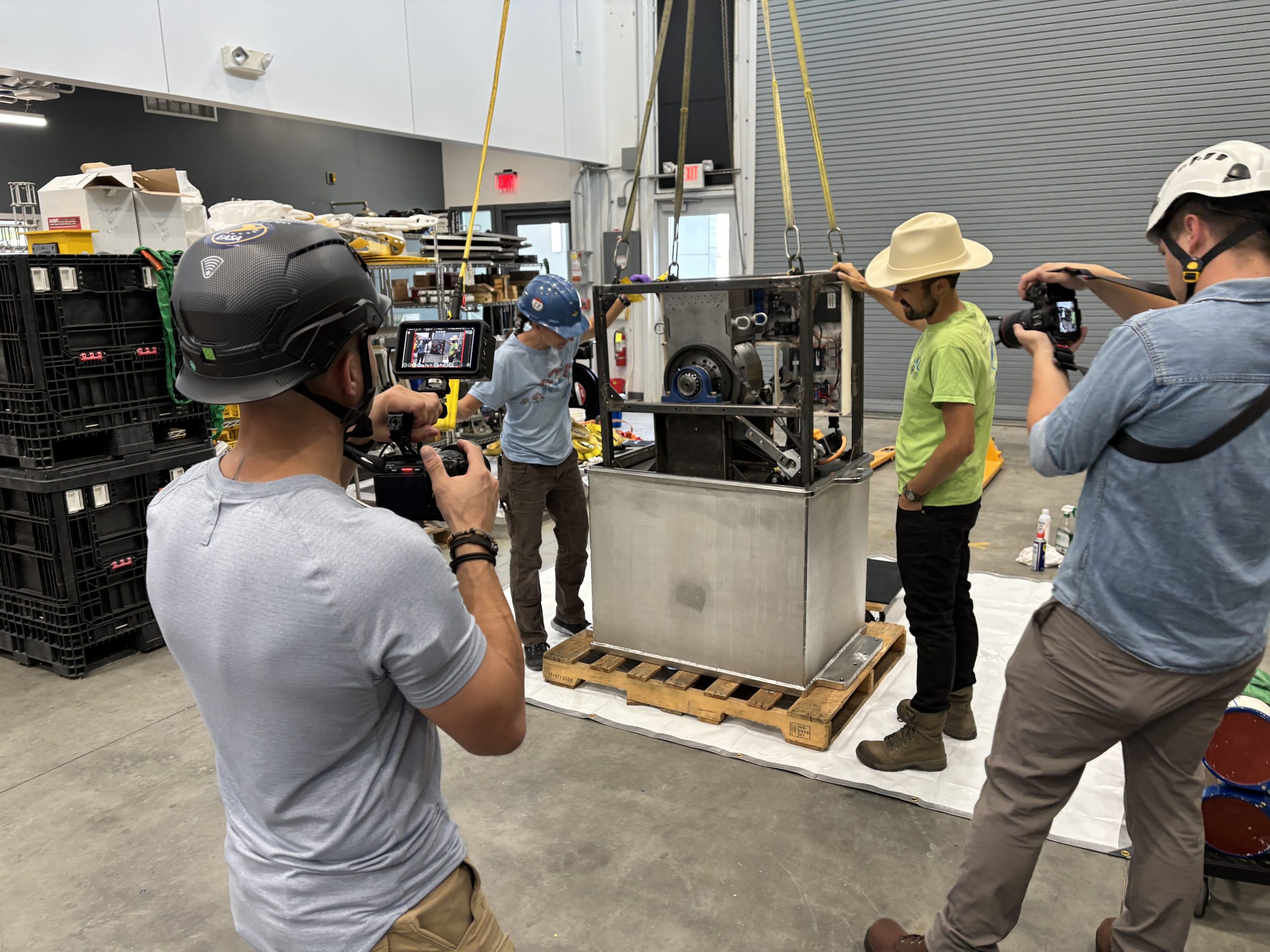 Joshua Bauer, NREL; Taylor Mankle, NREL; Meghan Donohue, WHOI; and Alex Franks, WHOI, install the WEC system into its watertight housing. © Ken Kostel, WHOI[/caption]
Read More
Joshua Bauer, NREL; Taylor Mankle, NREL; Meghan Donohue, WHOI; and Alex Franks, WHOI, install the WEC system into its watertight housing. © Ken Kostel, WHOI[/caption]
Read More OOI Community Status Update
Dear OOI Community,
We want to share with you important updates about the Ocean Observatories Initiative (OOI) for the upcoming year. The U.S. National Science Foundation’s (NSF) FY2026 budget request proposes a reduction in funding for OOI. While this is not final given the ongoing congressional appropriations process, it is important to share with the community the potential impact to operations starting in October 2025.
Since its inception, the OOI has been a cornerstone of sustained ocean observation – designed as a 30-year program to provide transformative science and open-access data. Now entering its tenth year, the OOI has grown into an important community resource that supports discovery, advances research, facilitates technology development, and fosters collaboration across the ocean community. Our commitment remains to ensure continuity of operations, manage this essential resource, and sustain the research and innovation it enables.
Despite the budget uncertainty, the OOI Leadership team’s commitment remains strong. We will continue to keep you informed as the congressional appropriations and agency implementation process unfolds and will share more details as they become available. We are actively working with NSF to explore strategies for long-term stability that secure the observatory’s future. In parallel, we are seeking new partnerships and opportunities to broaden support and strengthen the program’s foundation. We continue to encourage research proposals to use the present and historical OOI observations, and when appropriate leverage in-water assets.
If the president’s budget hold results in reduced NSF funding, we remain committed to maintaining core capabilities that safeguard high-value observations and ensure community access.
- Providing data delivery and distribution from all active instruments, including real-time data where enabled, and data from the past ten years of deployments from our Data Center.
- Operating the Regional Cabled Array (RCA) infrastructure to ensure continued access to the seafloor and a reduced set of water-column data from the deep ocean.
- Operating a scaled-down Pioneer Mid-Atlantic Bight Array with two service cruises and refurbished infrastructure this upcoming year.
- Continuing to provide data from the currently deployed infrastructure at Station Papa and the Irminger Sea Array. The Global Arrays are being operated at reduced sampling to extend their lifetime for the upcoming year.
- Maintaining limited Endurance Array capability by operating the Newport line deep glider during October and November 2025 and leaving the Oregon Shelf mooring in the water until spring 2026 (these activities are exceptions to the broader suspension of Endurance operations planned after Fall 2025 asset recovery).
- Continuing investments in OOI Data Services, including improvements to the Data Explorer and data processing tools.
- Meeting critical obligations such as permitting, reporting, and cybersecurity improvements.
To align with the potentially reduced budget in FY 2026, OOI operations will be scaled back in several areas. This includes the suspension of operation of the Endurance Array after asset recovery in Fall 2025, with the exception of operating the Newport line deep glider during October and November 2025 and leaving the Oregon Shelf mooring in the water until spring 2026; reduction or suspension of the glider and AUV operations; and suspension of the maintenance cruises for the global and cabled arrays in the upcoming project year.
We recognize these potential changes could disrupt coverage and continuity, particularly for studies that depend on near real-time data, cross-shelf observations, and sustained time series. Collaborations with partner institutions and contributions to regional observing networks may also be affected.
At the same time, the OOI remains committed to serving the community by preserving as much scientific capability as possible within the available funding.
In closing, we encourage you to actively highlight the value and impact of OOI by including it in your proposals, publications, presentations, and conversations with colleagues. Your engagement is vital to demonstrate the scientific impact and wide-ranging applications enabled by the OOI, underscoring its importance as a resource for the oceanographic community.
For any questions related to the OOI, please reach out to the Leadership Team at ooi@whoi.edu.
Sincerely,
The OOI Team
Disclaimer: Any opinions, findings and conclusions or recommendations expressed in this material are those of the authors and do not necessarily reflect the views of the National Science Foundation
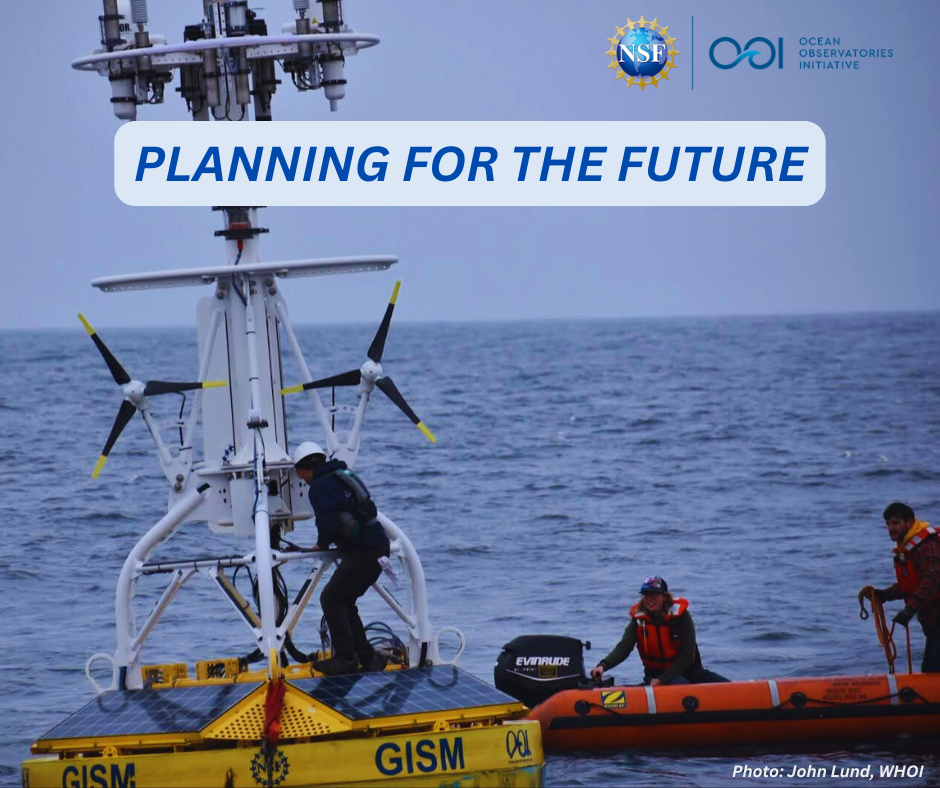
This research vessel studies an underwater volcano off Oregon’s coast
The Research Vessel Atlantis is a ship currently around 300 miles off of the Oregon Coast, as it monitors the Axial Seamount underwater volcano and replaces sensors and equipment that are part of the Regional Cabled Array. Read more from Fox 12 Oregon.
Read MoreMiniboat Hesperia Deployed from R/V Atlantis During OOI RCA Cruise
On August 24, 2025, during the 2025 Regional Cabled Array (RCA) Operations and Maintenance cruise, a small miniboat named M/B Hesperia was launched into the Pacific. About two hours after departing Axial Seamount, the boat was carefully deployed by hand off the starboard side of the R/V Atlantis.
The deployment was conducted at 15:31 PDT by Bosun Ed Popowitz and Able-Bodied Seaman Esteban Mogollon at coordinates 45.809950° N, 129.575011° W. The launch was met with enthusiasm and excitement from the crew, who gathered to watch Hesperia set sail.
This effort supports the Educational Passages Program and the Oregon Coast STEM Hub, part of Oregon Sea Grant, helping connect students and communities with ocean science through hands-on exploration.
You can follow the journey of M/B Hesperia in real time here: Track the boat.
[caption id="attachment_36992" align="alignnone" width="1280"]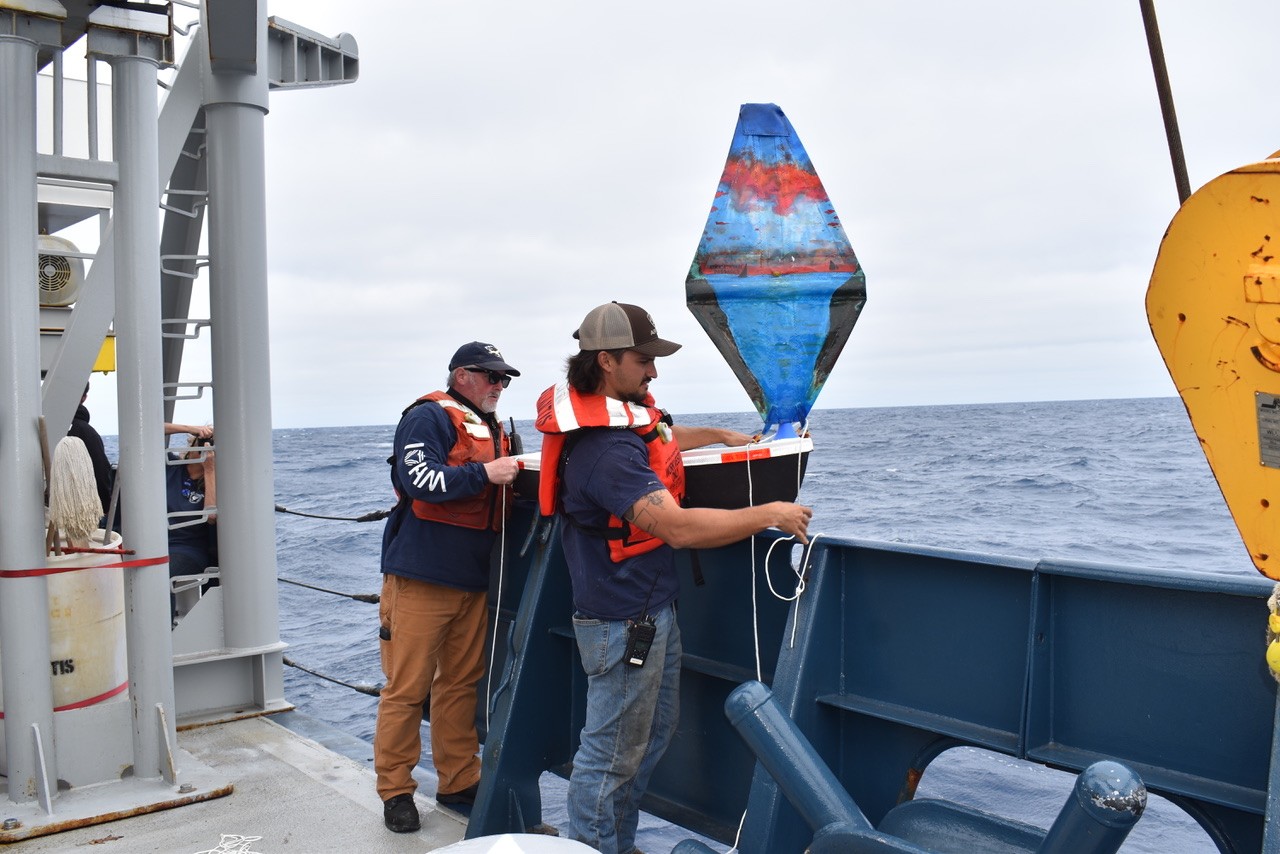 M. Elend, University of Washington, V25[/caption]
[caption id="attachment_36994" align="alignnone" width="1280"]
M. Elend, University of Washington, V25[/caption]
[caption id="attachment_36994" align="alignnone" width="1280"]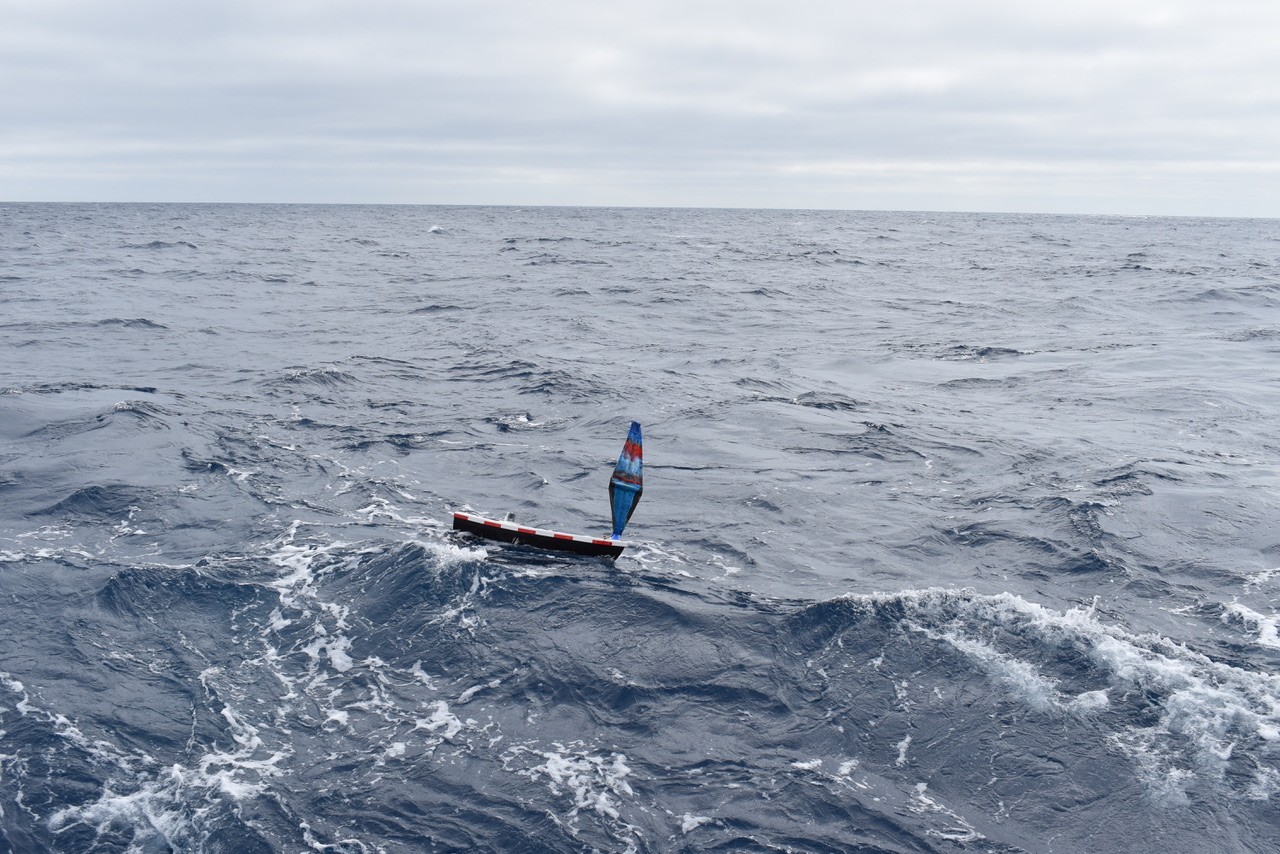 M. Elend, University of Washington, V25[/caption]
[caption id="attachment_36995" align="alignnone" width="1280"]
M. Elend, University of Washington, V25[/caption]
[caption id="attachment_36995" align="alignnone" width="1280"]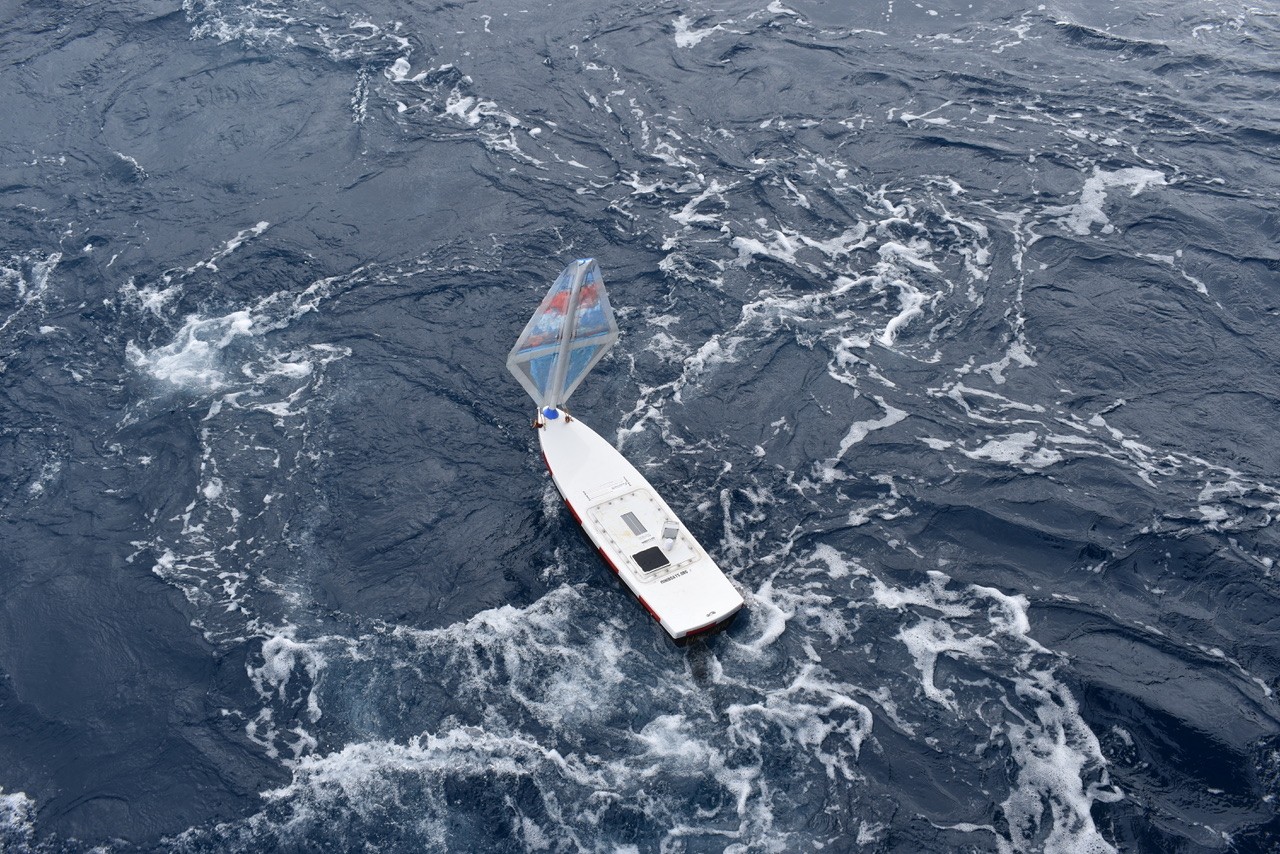 M. Elend, University of Washington, V25[/caption]
Read More
M. Elend, University of Washington, V25[/caption]
Read More New Measurements Capture Variability at the Edge of the Gulf Stream
The Ocean Observatories Initiative (OOI) Pioneer Array plays an important role in advancing our understanding of the Mid-Atlantic Bight and its dynamic interactions with the Gulf Stream. The Gulf Stream separates from the continental shelf northeast of Cape Hatteras and is found just offshore of the Pioneer MAB Array at its new location east of Nags Head, North Carolina. The Pioneer MAB science drivers include investigation of shelf-slope exchange that may result from Gulf Stream eddies and meanders. In order to capture variability offshore of the shelf, the Pioneer moored array extends offshore, but only to water depths of 300 m to avoid direct interaction with the Gulf Stream.
To supplement the Pioneer Array observations while enabling investigation of mesoscale variability, identifying western excursions of the Gulf Stream north wall, and detecting the upper portion of the Deep Western Boundary Current (DWBC), specialized instruments were deployed in deeper water. PI Magdalena Andres (WHOI), supported by an NSF Rapid Response Research (RAPID) grant, deployed two current- and pressure-sensor-equipped inverted echo sounders (CPIES; Fig. 1) on the 1000 m isobath. The two CPIES are about 40-km apart and are positioned to allow comparison with a glider which is running a north/south line (nominally) along the 1000 m isobath.
The CPIESs were deployed in June 2024 and will remain on site for four years. They are equipped with Popup Data Shuttles (PDSs) that return batches of data via satellite at regular intervals throughout the deployment. The CPIES measure round-trip vertical acoustic travel time with bursts of 16 pings every 10 minutes, along with near-bottom pressure and current measurements every 30 minutes. Travel time provides information about vertical density structure. Bottom pressure helps to diagnose large-scale barotropic circulation and sea level changes. Near-bottom currents give local flow conditions and help resolve ambiguities between baroclinic and barotropic contributions.
The first round of PDS data has been processed and is available to the community. Hourly processed data and lowpass filtered data from the two deployments sites can be accessed from a listing on the Community Data Sets page of the OOI website, or directly from the CPIES Data Set landing page. The new CPIES observations are complementary to the Pioneer Array measurements, extend the Array footprint offshore, and provide unique data for exploring mesoscale variability associated with the Gulf Stream and DWBC.
[caption id="attachment_36971" align="alignnone" width="1039"] Figure 1. Map showing CPIES locations (red dots, site C1 to the north, C2 to the south) relative to the Pioneer MAB moorings (yellow dots) and the Pioneer Offshore Flux glider line (blue). The red line is the time-averaged position of the Gulf Stream core and the dotted lines are Jason satellite altimetry tracks. Heavy contours are the 200 and 1000 m isobaths.[/caption]
[caption id="attachment_36972" align="alignnone" width="1635"]
Figure 1. Map showing CPIES locations (red dots, site C1 to the north, C2 to the south) relative to the Pioneer MAB moorings (yellow dots) and the Pioneer Offshore Flux glider line (blue). The red line is the time-averaged position of the Gulf Stream core and the dotted lines are Jason satellite altimetry tracks. Heavy contours are the 200 and 1000 m isobaths.[/caption]
[caption id="attachment_36972" align="alignnone" width="1635"] Figure 2. Data returned via satellite from the first two Popup Data Shuttles from CPIES at site C1(blue) and C2 (red). Hourly and two-day lowpass filtered records are shown for (a) round-trip acoustic travel time, (b) bottom pressure, (c,d) near-bottom meridional and zonal currents.[/caption]
Read More
Figure 2. Data returned via satellite from the first two Popup Data Shuttles from CPIES at site C1(blue) and C2 (red). Hourly and two-day lowpass filtered records are shown for (a) round-trip acoustic travel time, (b) bottom pressure, (c,d) near-bottom meridional and zonal currents.[/caption]
Read More CI Compass Interns Showcase Innovative Summer Research with OOI
The CI Compass Fellowship Program (CICF), funded by the U.S. National Science Foundation (NSF), prepares undergraduate students for careers in cyberinfrastructure through both training and applied research opportunities. The program begins with a 12-week virtual Spring Program, where students are introduced to skills essential for cyberinfrastructure careers at NSF Major or Mid-scale Facilities. Following the spring training, students may apply for the Summer Program, which places a limited number of Fellows in hands-on projects at collaborating NSF facilities.
Through this pathway, CI Compass Fellows Ejay Aguirre and Dylan Hermosillo earned internships with OOI this summer, where they applied their training to advance projects at the intersection of ocean science, cyberinfrastructure, and data analysis.
One project focused on connecting large-scale climate phenomena with accessible environmental data. Ejay Aguirre, an undergraduate at the University of Utah, integrated datasets from OOI, Ocean Networks Canada (ONC), and the National Ecological Observatory Network (NEON) to investigate how the El Niño Southern Oscillation (ENSO) is reflected across different monitoring sites. Using Python and Jupyter Notebook, he built a workflow for retrieving, cleaning, and comparing data across infrastructures. The analysis revealed that site characteristics, particularly latitude, influence the visibility of ENSO signals, with higher-latitude sites exhibiting weaker short-term patterns. Future work includes expanding the study to additional sites for broader spatial coverage, incorporating other climate indicators such as the Pacific Decadal Oscillation (PDO) and North Pacific Gyre Oscillation (NPGO), and publishing a publicly accessible, fully documented Jupyter Notebook to support reusability within the research community.
The second project addressed the challenge of monitoring ice conditions in the North Atlantic. Dylan Hermosillo, who will begin a PhD program in Bioinformatics at North Carolina State University, developed a convolutional neural network for ice detection using images collected by cameras mounted on a surface buoy at the OOI Irminger Array. The project stemmed from anomalies in buoy sensor data caused by iced-over instruments, which prompted the addition of cameras as supplementary monitoring tools. He worked with approximately 256,000 images, applying preprocessing steps such as pixel normalization and consistency checks. Tools like Dyno v2 and Facebook AI’s image similarity search were used to sort and filter the dataset. While challenges remained with image resolution and varying camera perspectives, the project demonstrated the feasibility of using buoy-mounted cameras to detect ice flows. Future directions include applying similar methods to cloud separation studies and exploring the integration of instruments such as solar meters to enhance atmospheric observations.
Reflecting on their progress, Jeffrey Glatstein, Senior Manager of Cyberinfrastructure at OOI noted, “Both Ejay and Dylan demonstrated how student researchers can make meaningful contributions when given the opportunity, providing fresh perspectives and impactful solutions that help advance OOI’s mission.”
As the CI Compass Fellowship Program continues to grow, it provides an important opportunity for developing the next generation of scientists and researchers engaged in cyberinfrastructure and data-intensive science.
Learn more about the CI Compass Fellowship Program by visiting the CI Compass website.
For those interested in the application process of the program, please visit the CI Compass Fellowship Program’s application process webpage.
[caption id="attachment_36916" align="alignnone" width="4801"]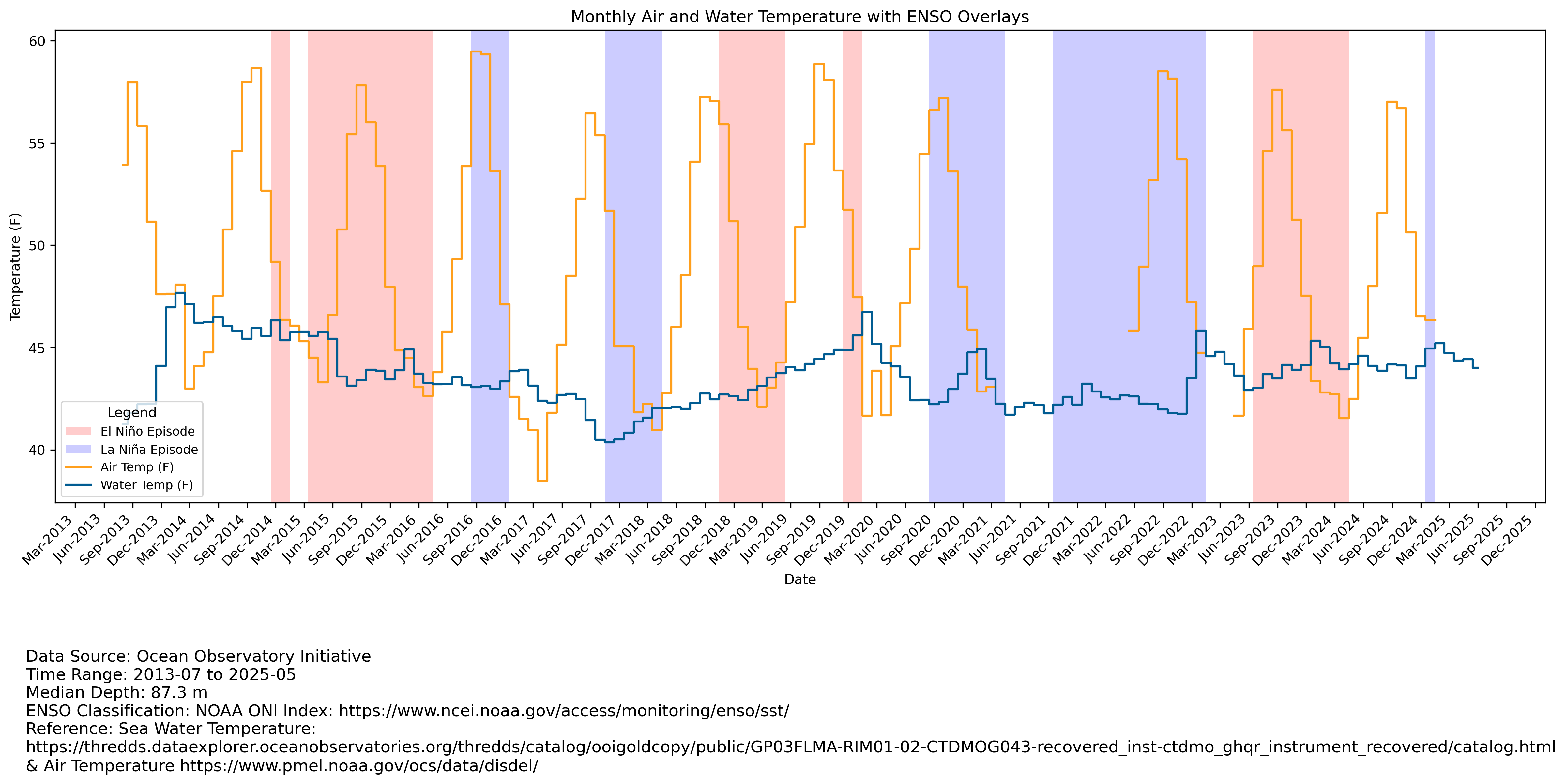 Air and water temperature plot generated from OOI data.[/caption]
Read More
Air and water temperature plot generated from OOI data.[/caption]
Read More 


